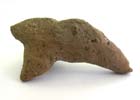Throughout the three phases present at Salat Camii Yanı the pottery assemblage is comparable to that of North Mesopotamian sites. The change in ware-type through the sequence can be described as a transition from mineral-tempered burnished ware to plant-tempered coarse ware or from ware-type typical of the beginning of the Pottery Neolithic to that of the Proto-Hassuna.
Phase 1
The pottery from the earliest phase is accounted for by burnished ware with mineral inclusion. Some variations including those characterized by a large quantity of large grit temper are present. The surfaces are usually well burnished and consist of light reddish-brown to dark grey tones. There are also a few sherds that include a small amount of fine vegetal temper in addition to mineral inclusion. The vessel shapes are simple, not having a clear neck or carination. Deep, closed forms and those with a flat base are common. Ledge handles or lugs which are sometimes attached below the rims are characteristic of Phase 1 pottery. The pottery in Phase 1 parallels the earliest pottery groups, so-called Early Mineral Ware, recently attested at Akarçay Tepe, Mezraa Teleilat, Tell Halula, Tell Sabi Abyad I and Tell Seker al-Aheimar.
Phase 2
The pottery in Phase 2 shows marked differences from that in Phase I. Mineral-tempered burnished ware, used continuously from Phase 1, occurs sporadically. In this phase the greatest part of the pottery is accounted for by plant-tempered coarse ware, which contains a large amount of plant inclusions as well as grits. The vessel walls are relatively thick, and dark cores are clearly visible in its section. The surface has a light tone, ranging from reddish-brown to buff, and is usually finished by smoothing. However, this change from mineral-tempered burnished ware to plant-tempered coarse ware should be understood as transitional one, also known from other North Mesopotamian sites. Vessel shape remains simple although some changes from Phase I are seen. Hemispherical bowls and jars with incurving rims are common in this phase. Ledge handles continued to be used. Handles attached on the rim also appear. Decorated sherds are absent.
Phase 3
The pottery in Phase 3 follows the tradition from Phase 2. Plant-tempered coarse ware continued to be the most predominant group. However, the amount of sherds recovered dramatically increases in this phase and some changes in pottery repertoires are seen. Firstly, new vessel shapes with relatively complex profiles, such as carinated bowls, ogee form pots, jars with distinctive necks and husking trays, were produced. Secondly, applied decoration, mostly simple knob-like ones but also wavy bands or an anthromorphic motifs, appear for the first time. Thirdly, some fine ware groups, such as painted pottery, dark burnished ware and red washed ware, join the assemblage. The pottery assemblage of Phase 3 can be identified as that of the Proto-Hassuna phase.
